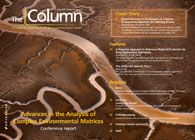Fluorochemicals in food packaging
High performance liquid chromatography?mass spectrometry (HPLC?MS) was used by Danish scientists to identify a potential hazard associated with new fluorinated chemicals widely found in many food packaging materials, including microwave popcorn bags and pizza boxes, according to a study in Toxicology and Applied Pharmacology.1 The chemicals have been implicated in the disruption of androgen synthesis.
High performance liquid chromatography–mass spectrometry (HPLC–MS) was used by Danish scientists to identify a potential hazard associated with new fluorinated chemicals widely found in many food packaging materials, including microwave popcorn bags and pizza boxes, according to a study in Toxicology and Applied Pharmacology.1 The chemicals have been implicated in the disruption of androgen synthesis.
Currently there is no European legislation regarding polyfluoroalkyl phosphate esters (PAPS) for paper and board food contact materials (FCM). This is despite other studies in the United States that have discovered that the human intestinal tract absorbs PAPs and that they can persist within the body for a number of years, according to the paper. Co-author of the study, Anne Marie Vinggaard, of the Technical University of Denmark, told The Column: “These chemicals are highly persistent, meaning that it takes years before they are excreted from the human body following exposure. Besides PFOA, diPAPS have been measured in human blood.”
HPLC–MS was performed by the team to analyse the levels of hormones excreted from cells following exposure to four specific chemicals — 8:2 monoPAPS, 8:2 diPAPS,10:2 diPAPS, and 8.2 triPAPS — to determine their toxicological effects on androgen synthesis and its effector pathways. Vinggaard told The Column that this is highly relevant as the signalling mechanisms are involved in the development of the male foetus, and that these chemicals may cause adverse effects on male development in animal experiments. Future studies are planned to determine if there is a risk to humans.
Reference
1. A.K. Rosenmai et al, Toxicology and Applied Pharmacology266, 132–142 (2013).
This story originally appeared in The Column. Click here to view that issue.

Analysis of PFAS in Milk by LC-MS/MS
May 15th 2025Dairy milk is one commodity that can be impacted by environmental contaminants, such as PFAS, so it is important to implement extensive, robust, and accurate testing. In this work, a sensitive and reliable method was developed for the analysis of PFAS in milk by LC-MS/MS at levels as low as 0.01 µg/kg.

.png&w=3840&q=75)

.png&w=3840&q=75)



.png&w=3840&q=75)



.png&w=3840&q=75)











